Where Diego flies upon a white seagull, gazes into golden halls, and climbs to the top of a black tower.
Yeah, I suppose I’ve gone a bit overboard with that rather fanciful introduction – though truth be told, it’s all not very far off the mark. In a manner of speaking.
First, let’s have at that white seagull.
Fair enough, it’s a train and not a bird. But at least they’ve got the colour in common, as well as the name: both are called kamome.
This particular Kamome is a series 885 train bound for Hakata Station, covering the distance between Nagasaki and Fukuoka in just shy of 2 hours – not bad for a non-shinkansen service. Wanting to conserve as much daylight sightseeing time as possible, I booked myself a seat on the first available high-speed service to Fukuoka (Kamome # 2), which was scheduled to depart at 6 AM.
Let’s have a quick look round.
My seat in the Green Car (first class) section of the train.
She’s quite a looker, this train: reclining leather seats (felt real too, not like faux upholstery), wood parquet floors, wall-mounted light fixtures. See that glass wall between the driver’s cab and the passenger cabin? It frosts over at the flick of a switch when the train is parked, then goes completely transparent when the driver has settled in and starts the train off on its journey, giving front-row passengers a great view out through the windshield. (At least, that was the case when I rode this same train to Nagasaki and the Green Car was at the front end; this time the Green Car was hauling the rear and the seats were rotated to face away from the glass wall.)
The series 885 train also has some nice common areas. This small general-purpose room is where I tucked into my store-bought breakfast.
The route from Nagasaki to Fukuoka.
After arriving at Fukuoka’s Hakata Station, I dropped my bags off at the hotel (too early for check-in) and hurried back to the platforms to catch the Kyūshū Shinkansen to Kumamoto.
Upon arriving, I boarded a tram from the stop in front of the railway station – they seem to love trams here in Kyūshū – and headed straight for the city’s main landmark, Kumamoto Castle. This is hardly the area’s only major tourist attraction, but with very limited time and as an incurable Japanese castle nut, it was an obvious choice for me.
The castle is also known as a great hanami spot, though I was a little too late for the blossoms this year. No matter: the permanent attractions are impressive enough.
From the tram stop, I walked to the castle complex and entered by way of the Hazekata Gate. Restoration work on the Bagu Turret was well under way, and I’d love to return in due course to see the fully rebuilt structure.
One of the first things you’ll see after the gate is the splendid Iida-maru turret. And just look at the scale of those walls!
At an intersection not far from the gate, visitors are faced with a choice of two courses: one highlighting the castle’s stone walls and the other featuring some of the castle’s surviving yagura (turrets). Each course takes about 2 hours to complete. Much as I would have wanted to tour the whole massive complex, with the clock ticking fast, I turned left and set myself on the first route. This took me on a twisting path that wove through the castle’s formidable fortifications.
Impressive as they are now, I’ll bet these walls must have looked even more intimidating back in the castle’s heyday, topped with wood-and-tile defensive towers and bridged by massive gates.
Further on along the path is the Niyō-no-Ishigaki, or “two-style stone wall”, so named because of the two different styles used in its construction. The more gently sloping section on the right is older, whereas the steeper part on the left is a later extension.
Note the scale of the walls behind the two visitors in the next shot. Bear in mind that these walls aren’t even among the largest specimens in the castle compound.
The stone ruins in the following image are believed to be of the shichi-beya, a house where the wife and children of a samurai would be held hostage to guarantee his loyalty to the castle lord.
Moving along, we pass between more of the castle’s enormous walls as we approach the main keep.
At one point along the route, we find ourselves standing right below the base of the massive tenshu (castle tower).
Passing through the Kuragari Gate, we find ourselves in a sheltered passageway that runs underneath the lord’s palace.
One of the entrances to the palace would have been up these stairs, although in the reconstruction the opening was not rebuilt. Some of the steps were reproduced to mark the spot.
Finally, we emerge back into the bright sunshine and come face to face with the mighty castle tower.
The building we see today is a concrete replica of the wooden original, which was destroyed in 1877 during the Seinan War. Replica or not, the tower continues to shock and awe the hordes of tourists who have replaced the armies that once besieged it.
On one side of the honmaru – the inner citadel where the main tower is located – stands a partial full-size reconstruction of Kumamoto Castle’s palace building, the original of which was also a casualty of the Seinan War. Unlike the concrete tenshu, the palace was resurrected using authentic construction techniques and materials, and since its opening in 2008 it has given visitors a rare glimpse at what life was like for the great daimyō of centuries past.
A model of the original palace complex, housed in one of the reconstructed rooms. Note the relatively small portion that has been rebuilt so far (marked with the darker grey roofs). Imagine how splendid it would be if the entire structure is eventually restored.
The reconstruction includes the palace kitchens, complete with stone-lined hearths.
A recreation of the dinner served to the castle lord in November 1860.
The main hall of the palace, looking towards the Wakamatsu-no-ma – the gilded inner room at the far end where the lord sat at one of his great audiences – as viewed from the Tsuru-no-ma. This long chamber actually consists of a series of rooms, of increasing importance as one moves towards the other side, with higher-ranked vassals no doubt seated closer to the far room and lesser personages closer to where we stand.
Bear in mind that the walls and sliding doors would originally have been richly decorated, and not left plain as they are in this reconstruction. Perhaps once enough funds become available the original decorative scheme could be applied to the whole.
The outer passage running alongside the rooms of the main hall.
As I mentioned previously, this great hall consists of a series of interconnecting rooms, each with its own decorative theme. Except for the two most important rooms, the artwork has not yet been restored, but if you’ve been to Nijō Castle in Kyōto you’ll have seen a similar set of linked chambers (intact in that case) and can probably imagine what the rooms would look like when the blank spaces are filled up with beautiful illustrations. Starting from where we stood earlier and working our way towards the innermost chamber:
At last, coming to the end of the cavernous hall, we find ourselves looking into the Wakamatsu-no-ma, where the lord of the castle would have presided over audiences with his vassals. Judging from the name, the decoration would revolve around young pine trees, although I’m no botanic expert so I can’t positively identify the greenery painted upon the walls.
In any case, whether depicting young pines or any other kind of plant, the gleaming artwork gracing the walls and sliding door panels are very impressive indeed.
Nice, eh? But wait, there’s more! Round the corner, an open doorway allows us to gaze into an even more magnificent room that’s connected to the main hall at a right angle. Behold the gilded splendour of the Shōkun-no-ma: the grandest reception hall in the entire palace. For smaller functions, the castle lord would hold court here and his subjects would be seated in the adjoining Wakamatsu-no-ma.
The utterly magnificent wall and panel paintings are a depiction of the ancient Chinese legend of Wang Zhaojun. No expense was spared – even the ceilings were lavishly gilded and covered in delicate floral artwork.
A nearby room displays more door art from other parts of the palace.
Another view of the reconstructed palace.
Let’s head for the castle tower now – it’s the star attraction after all.
The reconstructed tenshu looks very authentic from the outside. But once we step through the gate . . .
. . . we discover that the faithfully reproduced exterior is just a shell hiding a rather unattractive concrete structure within, which now serves as museum space. Don’t get me wrong: the museum is well worth visiting and has some good exhibits; the disappointment is more with the lost opportunity to rebuild the tower exactly as it once was. (Still, I’ve heard whispers about a plan to reconstruct Nagoya Castle – a similar nice-outside-but-concrete-inside replica – out of wood and using traditional techniques, so not all hope is lost for Kumamoto.)
One of the displays is a fine model of the castle back in its heyday, complete with the surrounding town.
There are some great views to be had from the upper floors. Also, you’ll have noticed from the exterior photographs shown earlier that the castle keep has two towers. If you want your money’s worth, don’t forget to climb the smaller one as well!
A few shots taken from near the castle tower. The second one below is of the only multi-storey turret to have survived intact on the castle grounds – but we’ll get to that in due course.
In the courtyard just west of the tenshu is a stone with a story to tell.
In the late 16th century, a man whose father was killed in a battle against Katō Kiyomasa – the builder of Kumamoto Castle – saw an opportunity for vengeance during the construction of the mighty fortress. He managed to enter the site by posing as a labourer, but was caught and executed. The man was said to have possessed great strength and carried this massive stone (all 1,800 kg of it) to the castle site in his failed assassination attempt.
The courtyard where the stone stands also affords visitors a great view of the western side of the castle keep.
Guarding the northwestern corner of the courtyard is the splendid Uto-yagura. Built mainly of pine wood, this is the castle’s only remaining original (i.e., not rebuilt or reconstructed) multi-storeyed turret, having survived the Seinan War and the many decades that came after.
True to its purpose as a watchtower, the Uto-yagura has a commanding view over this part of the castle grounds.
And finally, our time at Kumamoto Castle is nearing its end. Now for the long trek back to the station – but even this allows us even more opportunities to admire the fortress’ huge network of defences.
Next on our itinerary: an all-too-brief stay in the fine city of Fukuoka.













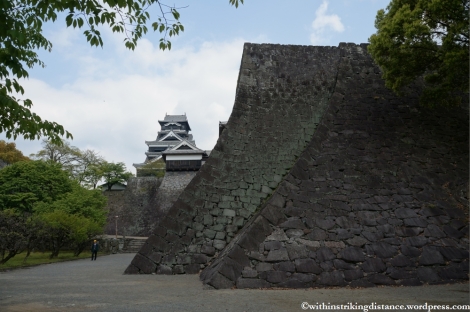














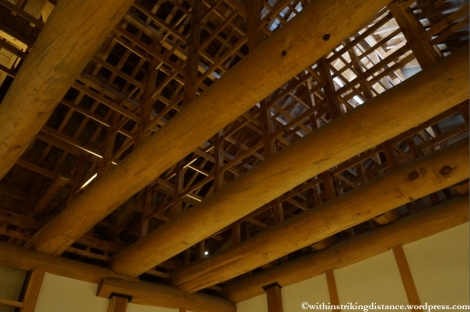




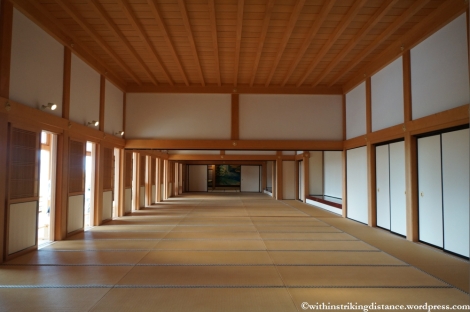





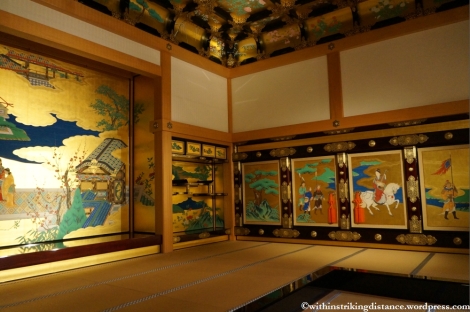











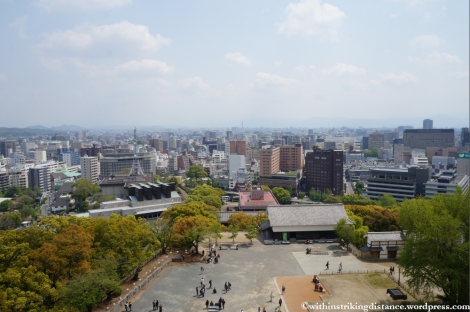














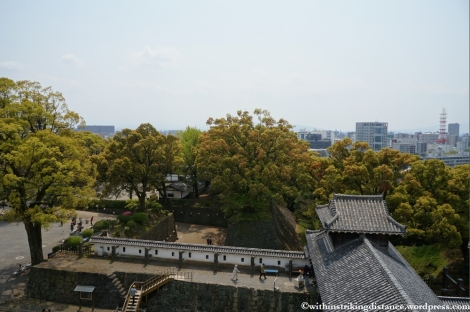


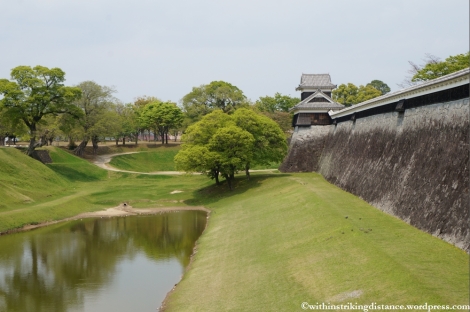


Pingback: Field Report: Fukuoka (09 April 2013) | Within striking distance·
Pingback: Field Report: Kyōto (11 April 2013) – Part 1/2 | Within striking distance·
On our visit to Kumamoto castle, we missed seeing the partial full-size reconstruction of the palace building. We will definitely have to catch it this time around. I’m also looking forward to seeing the Hosokawa samurai mansion on the castle grounds. I enjoyed seeing Kumamoto Castle but, like you, was somewhat disappointed by the concrete museum inside. I really want to devote a trip to visiting all of Japan’s original castles. When I went to Kochi Castle, I was just blown away by the beauty of its interior. Fantastic post!
You’ll want to visit Nagoya Castle then – they’ve just opened a newly reconstructed section of the lord’s palace there.
http://www.japan-guide.com/blog/schauwecker/130710.html
The rest of the building is still a work-in-progress and will be revealed to the public in stages. I can’t wait to see the grand hall in the next link (still under wraps), though it probably won’t be ready for another few years or so.
http://www.hommaru-palace.city.nagoya.jp/02_fukugen/02_02_edemiru/02_02_04_jouraku/index.html
Pingback: Field Report: Nagoya (13 February 2014) – Part 1/2 | Within striking distance·
Pingback: Forget the goose that laid the golden egg – bears are better at minting money | ディエゴの日々·
Pingback: Field Report: Suizen-ji Jōju-en, Kumamoto, Japan (27 March 2015) | Within striking distance·
Pingback: Field Report: Suizen-ji Jōju-en, Kumamoto, Japan (27 March 2015) | Within striking distance·
Pingback: Field Report: Kumamoto Castle, Japan (27 March 2015) | Within striking distance·
Pingback: Field Report: Kyū Hosokawa Gyōbu-tei, Kumamoto, Japan (27 March 2015) | Within striking distance·
Pingback: Field Report: Kawagoe, Japan (01 October 2016) | Within striking distance·
Pingback: Field Report: Kōchi Castle, Japan (19 November 2016) | Within striking distance·
Pingback: Field Report: Akō Castle, Hyōgo Prefecture, Japan (20 November 2016) | Within striking distance·
Pingback: Field Report: A Morning Trip to Kitakyūshū, Fukuoka Prefecture, Japan (23 September 2018) | Within striking distance·